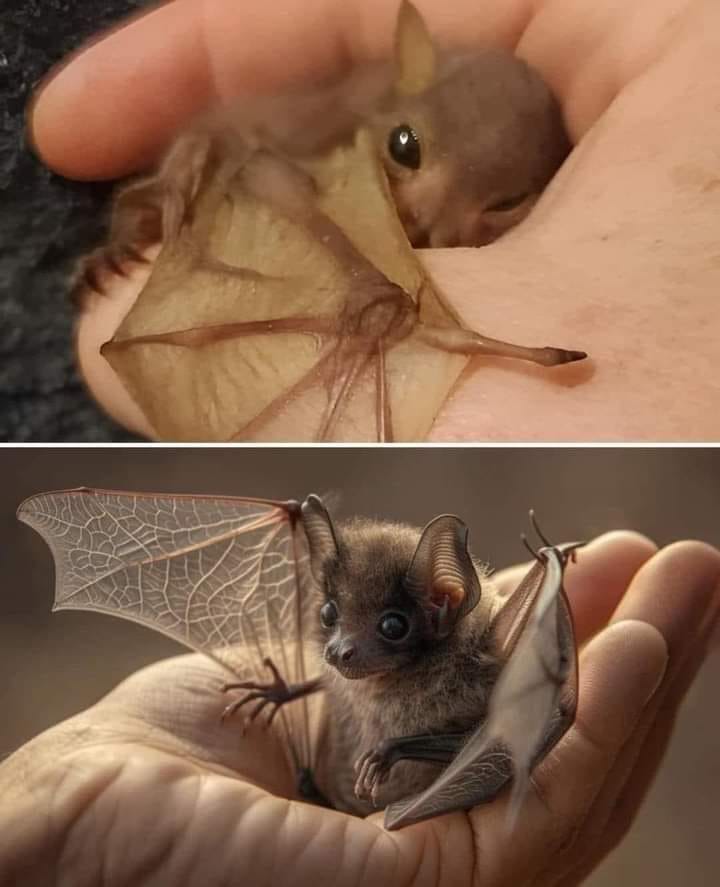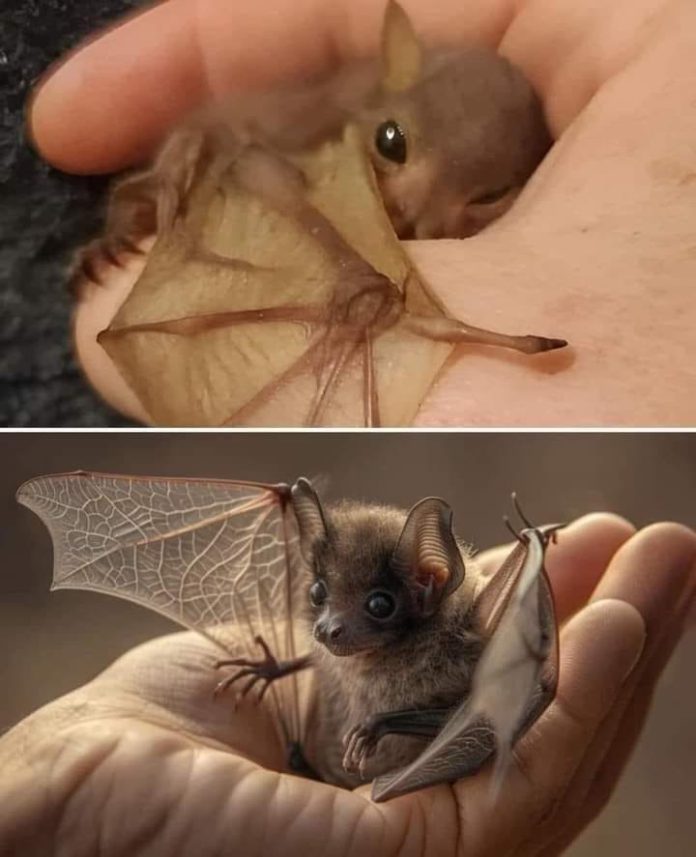Hello… I’m a bat… I don’t suck blood and I don’t want to get stuck in your hair.
If I accidentally walk into your house, please don’t hit me with sticks or brooms, it really hurts and I’m very scared.

It was an accident, I didn’t want to scare you. If I land, I may not be able to get up and I need your help. Just use a towel to get me out and I’ll fly right away, I promise. I eat mosquitoes and many other insects. Our houses are being demolished for other buildings and we only have a few places to shelter. so if I fly into your house, turn off the lights, leave the outside light on and leave the door open, I’ll be out in a heartbeat.
Be a human, I want to live too….
All About Bats
Bats are one of the most fascinating and misunderstood creatures in the animal kingdom. They belong to the order Chiroptera, which is derived from the Greek words “cheir” meaning hand, and “pteron” meaning wing. This aptly describes the structure of a bat’s wing, which is essentially a modified hand with elongated fingers connected by a thin membrane of skin. Bats are the only mammals capable of true sustained flight, a feature that sets them apart from other winged animals like birds and insects.
There are over 1,400 species of bats, making them the second most diverse order of mammals, surpassed only by rodents. Bats are divided into two main suborders: Megachiroptera and Microchiroptera. The Megachiroptera, commonly known as fruit bats or flying foxes, are primarily found in tropical and subtropical regions. They have large eyes, which help them navigate during the day and at twilight, and rely heavily on their sense of sight and smell to locate food. Microchiroptera, on the other hand, are generally smaller and are found worldwide. They are primarily nocturnal and use echolocation to hunt and navigate in the dark. Echolocation is a remarkable adaptation that allows bats to emit high-frequency sounds that bounce off objects and return as echoes, enabling them to “see” with their ears.
Bats play crucial roles in various ecosystems, often acting as pollinators, seed dispersers, and pest controllers. In tropical regions, many plants rely on bats for pollination. The agave plant, for instance, which is used to produce tequila, depends almost exclusively on bats for pollination. Similarly, bats help in the dispersal of seeds for many plants, contributing to forest regeneration and biodiversity. Fruit-eating bats consume the pulp of fruits and then excrete the seeds in different locations, often far from the parent tree, promoting the growth of new plants. Insect-eating bats provide a natural form of pest control, consuming vast quantities of insects each night. A single bat can eat up to half its body weight in insects, including mosquitoes, moths, and beetles, thus reducing the need for chemical pesticides.
Despite their ecological importance, bats have long been the subject of superstition and fear. Many cultures associate bats with darkness, death, and malevolence, likely due to their nocturnal habits and their association with caves and other dark places. The image of the vampire bat, which feeds on the blood of other animals, has only fuelled these misconceptions. In reality, only three species of bats are true blood feeders, and they primarily target livestock, not humans. Most bats are harmless and pose no threat to people.
The study of bats, known as chiropterology, has revealed much about their complex social behaviours and sophisticated navigation systems. Bats are social animals, often living in large colonies that can number in the millions. These colonies provide warmth and protection, but they can also be noisy and crowded. Bats communicate with each other using a variety of vocalisations, including clicks, chirps, and even songs. Some species, such as the Brazilian free-tailed bat, are known for their elaborate vocal repertoire, which is thought to play a role in mating and social interactions.
Echolocation is one of the most studied and fascinating aspects of bat behaviour. When a bat emits a sound, it listens for the echoes that bounce back from objects in its environment. By analysing the time delay and the frequency shift of the returning echoes, the bat can determine the distance, size, shape, and even texture of objects. This allows it to navigate through complete darkness and to catch tiny, fast-moving prey. The ability to use echolocation varies among bat species; some are highly specialised, while others, like the fruit bats, rely more on their vision.
Bats have also adapted to a wide range of habitats and food sources. They can be found in almost every part of the world, except in extreme deserts and polar regions. Their diets are equally diverse. While some species are insectivorous, others feed on fruits, nectar, small mammals, fish, and even other bats. The infamous vampire bats feed exclusively on blood, a diet known as hematophagy. These bats have evolved specialised adaptations, such as heat sensors on their noses to locate blood vessels and an anticoagulant in their saliva to prevent blood from clotting while they feed.
The anatomy of bats is uniquely suited to their lifestyle. Their wings are made up of a double layer of skin stretched over elongated arm and finger bones. This structure is both strong and flexible, allowing bats to perform agile manoeuvres in the air. The wing membranes are covered in tiny muscles that help bats control the shape and movement of their wings, making them incredibly agile fliers. Bats also have a distinctive calcar, a spur of cartilage that extends from the ankle and supports the wing membrane. This feature is absent in birds and is one of the characteristics that distinguish bats from other flying animals.
Bats are known to hibernate or enter a state of torpor during periods of food scarcity, such as in the winter months. Hibernation allows them to conserve energy by significantly lowering their body temperature and metabolic rate. During this time, bats live off their fat reserves. Hibernating bats are vulnerable to disturbances, which can cause them to wake up and deplete their energy reserves, sometimes fatally. In recent years, hibernating bat populations have been devastated by a disease called White-Nose Syndrome, caused by the fungus Pseudogymnoascus destructans. This fungus grows on the skin of hibernating bats, particularly around their noses and wings, and disrupts their hibernation cycles, leading to dehydration, starvation, and death. The disease has killed millions of bats in North America since it was first identified in 2006.
Bats face numerous other threats, including habitat loss, climate change, and human disturbance. Deforestation and the destruction of caves and roosting sites have a significant impact on bat populations. Many bat species are highly specialised and rely on specific habitats or roosting conditions, making them particularly vulnerable to environmental changes. Climate change also poses a threat, as it can alter the availability of food and roosting sites, as well as increase the frequency and severity of extreme weather events. Human activities, such as caving, mining, and the use of pesticides, can also disrupt bat colonies and reduce their numbers.
Conservation efforts are underway to protect bat populations and their habitats. In many countries, bats are legally protected, and there are initiatives to create bat-friendly environments, such as the installation of bat boxes and the preservation of roosting sites. Public education and awareness campaigns aim to dispel myths and promote the ecological importance of bats. Research into diseases like White-Nose Syndrome is also ongoing, with the goal of finding ways to mitigate its impact on bat populations.
Bats have also made significant contributions to human knowledge and technology. Their echolocation abilities have inspired advances in sonar and radar technology, as well as medical imaging techniques like ultrasound. Studying the flight mechanics of bats has provided insights into the design of more efficient aircraft and drones. Additionally, the anticoagulant properties of vampire bat saliva have led to the development of new treatments for blood clotting disorders and stroke.
In some cultures, bats are revered as symbols of good luck, longevity, and prosperity. In China, the word for bat, “fu,” is a homophone for the word meaning “good fortune,” and images of bats are often used in decorative art to convey happiness and good luck. In other cultures, bats are associated with rebirth and transformation, as they emerge from their roosts at dusk, symbolising the transition from day to night.
Despite their often negative portrayal in popular media and folklore, bats are an essential part of our natural world. They provide invaluable ecosystem services, such as pollination, seed dispersal, and insect control, that benefit both the environment and human societies. The challenges they face, from habitat destruction to disease, highlight the need for continued research and conservation efforts to ensure their survival.
Understanding and appreciating bats requires us to look beyond the myths and misconceptions and recognise their unique adaptations, behaviours, and ecological roles. As nocturnal animals that thrive in a world often hidden from human sight, bats remind us of the complexity and diversity of life on our planet. Their presence in our ecosystems is a testament to the incredible adaptability and resilience of nature, and their survival is intertwined with the health and balance of the environments they inhabit.
Bats are extraordinary creatures that defy many of the stereotypes and fears associated with them. Their ability to fly, navigate in the dark, and adapt to a wide range of environments and diets make them one of the most versatile and successful groups of mammals. They play crucial roles in maintaining healthy ecosystems, and their conservation is vital for the preservation of biodiversity. By learning more about bats and supporting efforts to protect them, we can ensure that these remarkable animals continue to thrive and contribute to the natural world for generations to come.
KEEP US ALIVE and join us in helping to bring reality and decency back by SUBSCRIBING to our Youtube channel: https://www.youtube.com/channel/UCQ1Ll1ylCg8U19AhNl-NoTg AND SUPPORTING US where you can: Award Winning Independent Citizen Media Needs Your Help. PLEASE SUPPORT US FOR JUST £2 A MONTH https://dorseteye.com/donate/







